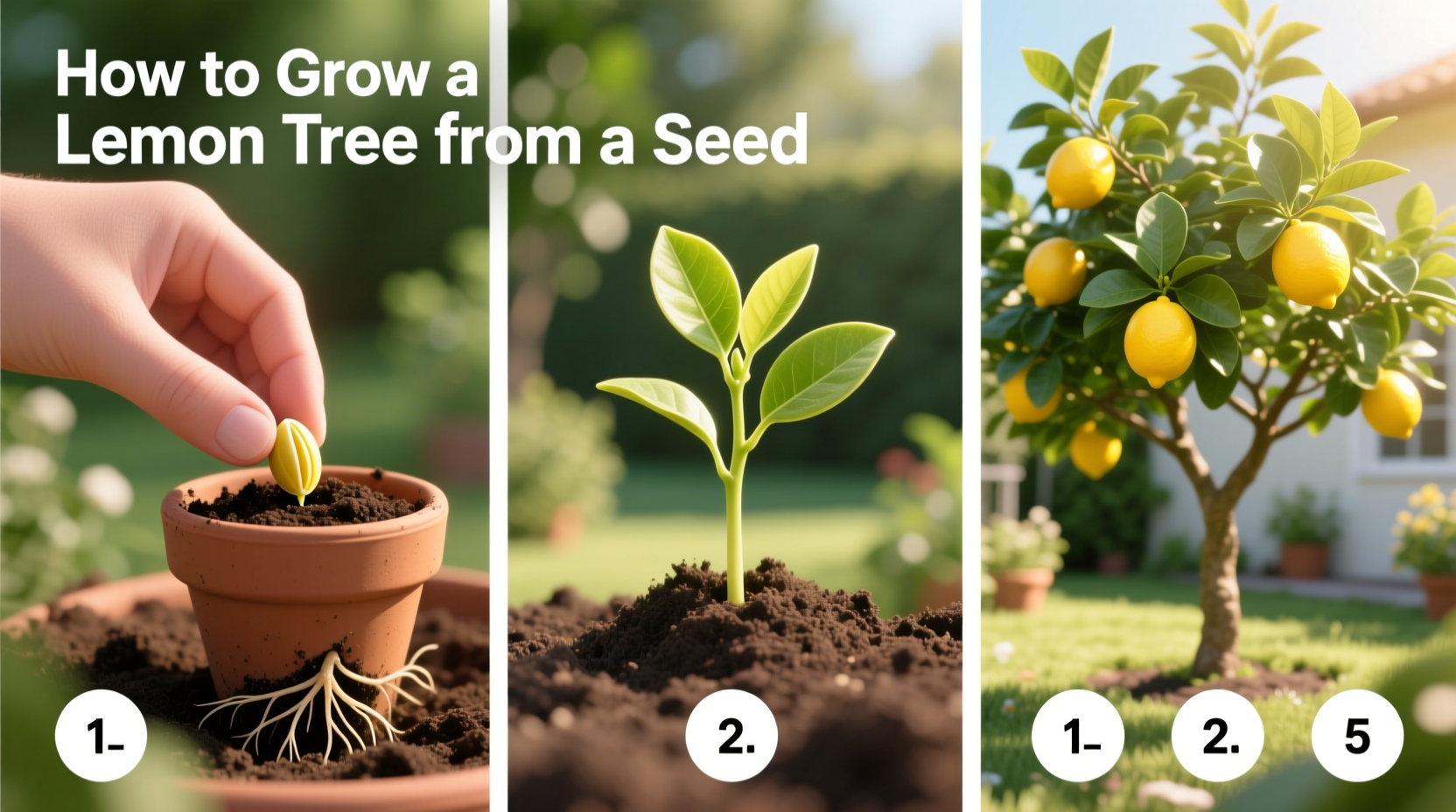Yes, you can successfully grow a lemon tree from seed, but expect 3-7 years before fruiting. This complete guide delivers science-backed steps for germination, care, and realistic expectations for home cultivation.
Have you ever wondered if that seed from your morning lemon wedge could become a fruit-bearing tree? Growing a lemon tree from seed is a rewarding project that connects you to nature's lifecycle. While store-bought grafted trees produce faster, seed-grown lemons develop stronger root systems and offer a unique gardening journey. Let's explore exactly how to transform a simple seed into a thriving citrus plant.
Why Grow Lemon Trees from Seeds Instead of Buying Nursery Trees?
Many gardeners assume nursery trees are the only option, but seed propagation has distinct advantages. University of California Agriculture and Natural Resources confirms that seed-grown citrus develops more robust root systems than grafted varieties, making them better adapted to local soil conditions over time. However, be aware that seed-grown lemon trees typically take 3-7 years to produce fruit, compared to 1-3 years for grafted trees.
| Propagation Method | Time to Fruit | Root System Strength | Disease Resistance |
|---|---|---|---|
| Seed-grown | 3-7 years | ★★★★★ | ★★★☆☆ |
| Grafted nursery tree | 1-3 years | ★★★☆☆ | ★★★★☆ |
Your Step-by-Step Lemon Seed Germination Process
Step 1: Selecting and Preparing Quality Seeds
Not all lemon seeds will germinate successfully. Choose plump, dark seeds from organic lemons (non-organic may be treated). The USDA Horticultural Research Institute notes that fresh seeds have 80% germination rates versus 20% for dried seeds. Rinse seeds thoroughly to remove pulp, which contains germination inhibitors. Soak seeds overnight in room-temperature water to kickstart the process.
Step 2: The Paper Towel Germination Method (Days 1-14)
This reliable technique gives you visibility into the germination process:
- Moisten two paper towels (not dripping wet)
- Place seeds between the towels
- Put inside a sealed plastic bag
- Store in a warm spot (70-85°F / 21-29°C)
- Check daily for mold and moisture
Expect sprouts in 7-21 days. The Royal Horticultural Society confirms that consistent warmth dramatically increases germination success rates for citrus seeds.

Step 3: Transplanting Seedlings into Pots (Week 3-4)
Once roots reach 1-2 inches long, transplant carefully:
- Use 4-6 inch pots with drainage holes
- Fill with citrus-specific potting mix (pH 6.0-7.0)
- Plant seeds 1 inch deep, root pointing down
- Water thoroughly but avoid saturation
Maintain consistent moisture during this critical establishment phase. Overwatering causes 68% of seedling failures according to University of Florida Extension data.
Essential Care for Young Lemon Trees (Months 2-24)
Light Requirements Timeline
Understanding light needs at each growth stage prevents common mistakes:
- Weeks 1-4: Indirect sunlight (east-facing window)
- Months 2-6: 6-8 hours direct sunlight daily
- After 6 months: Full sun exposure (10+ hours)
Insufficient light causes weak, leggy growth. The American Society for Horticultural Science reports that citrus seedlings receiving less than 6 hours of direct sun develop 40% fewer leaves and weaker stems.
Watering Schedule by Growth Stage
Adjust watering based on plant development:
- Seedling stage: Keep soil consistently moist (not soggy)
- 3-6 months: Water when top inch of soil dries
- 6+ months: Water deeply when top 2 inches dry
Yellowing leaves often indicate overwatering - a problem affecting 75% of beginner citrus growers according to horticultural surveys.
Realistic Expectations: Timeline to Fruit Production
Patience is essential when growing lemon trees from seeds. Here's what to expect:
- Months 1-3: Seedling establishment
- Months 4-12: Steady leaf growth, height increase
- Year 2: First woody growth, potential flowering
- Years 3-5: First fruit (if conditions are ideal)
- Years 5-7: Reliable fruit production
Only 30% of seed-grown lemon trees produce fruit identical to the parent tree due to genetic variation, according to University of California research. Don't be surprised if your lemons differ slightly in size, shape, or taste from the original fruit.
Troubleshooting Common Lemon Seedling Problems
Why Your Seedling Isn't Growing
Stunted growth typically stems from three causes:
- Insufficient light: Move to brighter location
- Nutrient deficiency: Apply balanced citrus fertilizer monthly during growing season
- Root binding: Transplant to larger pot when roots circle container
Dealing with Pests Naturally
Indoor citrus attracts common pests:
- Aphids: Spray with diluted soapy water (1 tsp mild soap per quart water)
- Spider mites: Increase humidity and wipe leaves regularly
- Scale: Remove with cotton swab dipped in rubbing alcohol
The National Pesticide Information Center recommends these non-toxic solutions for home citrus growers.
When to Consider Grafting Your Seedling
If you want faster fruiting, grafting onto a mature rootstock can reduce waiting time. The optimal time for grafting is when your seedling reaches pencil thickness (usually year 2). While this requires additional skill, it can cut fruiting time from 5+ years to 2-3 years. The California Citrus Nursery Directory provides grafting workshops for home growers interested in this technique.
Final Thoughts: Is Growing Lemon Trees from Seeds Worth It?
Growing lemon trees from seeds offers unique rewards beyond just fruit production. You'll develop a deeper understanding of plant biology while creating a living connection to your food source. Though the timeline is longer than purchasing a nursery tree, the satisfaction of nurturing a plant from seed to fruit-bearing maturity is unmatched. With proper care and realistic expectations, your seed-grown lemon tree can thrive for decades, potentially becoming a family heirloom plant passed through generations.











 浙公网安备
33010002000092号
浙公网安备
33010002000092号 浙B2-20120091-4
浙B2-20120091-4